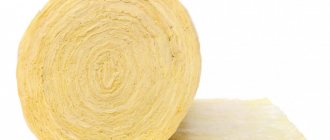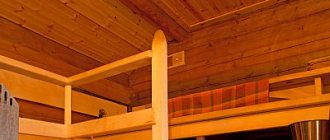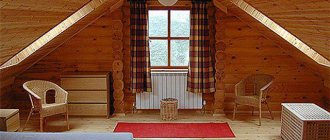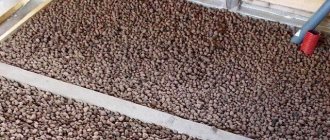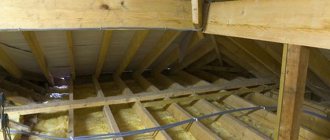The bathhouse is traditionally a place where you can rest, relax and improve your body's health. The main properties of the bath are acceleration of blood flow and activation of stagnation processes in the body. Each session spent in the steam room helps to get rid of accumulated waste and toxins, rejuvenate the skin and get rid of the feeling of fatigue. It is important to know that the effectiveness of these procedures directly depends on the correct arrangement of the bathhouse building.
The walls of the bathhouse, as well as its ceiling, must be insulated. This is especially true for the ceiling, since the ceiling is a high temperature zone. Heated air is always lighter than cool air, and because of this it rises, where it can go to the attic room and then move outside. Thus, thermal energy and heat heat the area around the bathhouse more, which is wasteful. An uninsulated bathhouse ceiling is a place for condensation to form. Its appearance signals that the process of insulating the bathhouse ceiling with expanded clay should begin as soon as possible. It is better to provide thermal insulation at the stage of building the bathhouse, then there will be no need for partial dismantling of the structure.
Main qualities of expanded clay
Expanded clay is a bulk material used in construction, which is produced on the basis of clay by high-temperature processing in special furnaces that rotate while firing the raw materials.
Expanded clay is actively used not only as a heat insulator, but also as a filler in the production of reduced-weight concrete.
Expert opinion
Konstantin Alexandrovich
The energy efficiency indicators, namely the thermal insulation of the material, are determined by its special structure, consisting of many pores. This allows you to create the effect of a thermos. The material varies in fraction size, which ranges from sand to crushed stone. For thermal insulation of the ceiling surface, expanded clay with granule dimensions from 10 to 20 millimeters is most often used.
Classification of expanded clay
The size of the granules is as follows:
- Expanded clay sand . The grain size of the substance is 0.1 - 10 millimeters. This material is mainly used as a filler in mortars, and also as backfill for insulating the ceiling area of bath buildings. The recommended backfill layer thickness is up to 50 millimeters. The cost is about 150 rubles per bag.
- Expanded clay gravel . The dimensions of granules of this material vary from 1 centimeter to 2 centimeters. It can be used for thermal insulation of any building premises. The approximate price is about 200 rubles per bag of material.
- Expanded clay crushed stone . The size of the fractions varies from 2 centimeters to 4 centimeters. In order for the backfill mixture to have a higher density, it is often used in combination with gravel. Prices start from 200 rubles per bag of crushed stone.
Conclusion
In order to insulate the ceiling in a bathhouse, you can use different insulation materials and each owner makes their own choice. If you want to save money, you can choose, for example, expanded clay or clay with sawdust, but the installation process is more labor-intensive.
Using materials such as mineral wool or penoizol allows you to complete all the work much easier and faster, but be prepared for more significant costs.
Do-it-yourself thermal insulation of a bathhouse ceiling with expanded clay
In order to make the ceiling surface warmer, it will not be enough to simply fill in the required layer of material. This process is characterized by a number of features that will need to be taken into account in order to obtain the desired result.
Do not forget that thermal insulation of the floor using expanded clay will create an additional load on the main structure of the building. To avoid problems, you will have to provide solid fastenings to the ceiling boards, and, if necessary, reinforce them.
Stage 1. Ensuring protection of the load-bearing surface from moisture.
For these purposes, it is recommended to use the following types of building materials of various types:
- roofing felt - produced in the form of rolls;
- membrane or film;
- mastic - applied by coating the surface.
Features of ceiling insulation with a warm and cold roof
By design, bathhouse premises can be divided into those that have an attic floor, that is, a warm roof, and those that do not have an attic, that is, a cold roof.
If there is an attic or attic floor that you plan to use, then in this case it is necessary to make a more powerful ceiling structure. In this case, the presence of a roofing system, which can also be insulated in the under-roof space, provides better heat retention.
If there is no attic in the bathhouse , then the air masses have fewer barriers, so the ceiling cools down faster and its insulation must be done better. Regardless of the design of the ceiling, during its thermal insulation, a vapor barrier layer, insulation and a waterproofing layer must be used.
Such a cake provides good thermal insulation, and the insulation, protected from moisture, will have a long service life and will not lose its original characteristics for a long time.
Laying technology
The principle of floor insulation with expanded clay is to arrange a heat-insulating layer into a prepared frame. First, a rigid base is prepared. If the material is poured directly onto the ground, it must be compacted well. Lay a row of waterproofing.
The next stage is the assembly of the frame, consisting of ordinary wide slats, reinforced with transverse bars.
In the case of a large insulation perimeter, it is recommended to divide the structure into several fragments.
The last thing is pouring the expanded clay mixture and fixing the fastening boards to the frame.
If the work is carried out under a screed, then the filled expanded clay is filled with a cement composition.
Checking completed work
After this, you need to ensure the quality of the insulation made. To do this, the bathhouse is heated and all sources of cold air (doors, ventilation, etc.) are closed. After warming up the room, the temperature is measured and the time is recorded. If it decreases quickly, then the insulation work was performed poorly. Then the reasons for the temperature drop are identified and eliminated. After this, the check is repeated. In a good sauna, the heat lasts up to 4 hours.
Periodically it is necessary to inspect the attic space for damage to the roof covering and moisture leaks. Such inspections are also necessary during heavy precipitation.
The ingress of water into the expanded clay layer significantly reduces its heat-saving qualities. Therefore, all leaks must be eliminated.
Insulating the ceiling alone will not solve the problems of maintaining heat in the room. Expanded clay is an almost ideal heat insulator, but only the integrated use of energy-saving technologies and materials will make your creation a truly Russian bathhouse.
Unpleasant property
Expanded clay has an unpleasant property - it is able to absorb moisture, but gives it away reluctantly, so waterproofing is required to protect it. On a pre-prepared concrete base, I spread a strong plastic film, the ends of which I brought onto the wall above the future layer. It didn’t take much to fasten the strips together with masking tape; after all, polyethylene is a fairly wide material.
Now it was necessary to install beacons for uniform falling asleep.
I prefer the method of arranging landmarks using dowels and self-tapping screws screwed into them. But here, out of fear that a few holes in the film would worsen the waterproofing, I preferred the old method of alabaster piles with short wooden blocks.
Carrying out work
Insulating the ceiling does not mean just pouring a layer of expanded clay. There are a number of nuances in this task that must be taken into account to obtain the desired result.
It should be remembered that insulation with expanded clay makes the structure heavier. Therefore, you will need to take care of the reliable fastening of the ceiling boards and, if necessary, strengthen them.
Before starting work, you need to prepare moisture and vapor barrier materials. The following options are valid:
- polyethylene film;
- roofing felt;
- aluminium foil.
Insulating a bathhouse begins with laying moisture-proofing materials. The simplest option is to apply clay coating to the ceiling boards. The thickness of such a vapor barrier should be 1.5–2 cm. The use of this insulation requires great physical effort and time. The coating takes at least 3 weeks to dry. Therefore, crumpled clay is used for the same purposes. Waterproofing is laid on the coating layer, the role of which is polyethylene film or roofing felt. The width of the material should be 10–15 cm greater than the distance between the floor beams. If the moisture barrier is laid overlapping, then the seams are glued with bitumen mastic or tape.
Expanded clay is poured between the beams, directly onto the prepared insulating material. Heat-saving properties are fully ensured when the insulation thickness is more than 10 cm. The recommended value is 14–16 cm. Expanded clay is poured into an even layer and leveled. For compaction purposes, material fractions of different sizes are used. Special attention is paid to the completeness of the backfill around the rafters, chimney and walls. The quality of laying the material directly affects heat loss. To prevent convection currents from occurring in the expanded clay layer, it is recommended to fill the insulating material with ordinary dry sand on top, having previously covered the expanded clay layer with agrofibre. It prevents sand from spilling out and does not create a “greenhouse effect.” Layer thickness – 3–5 cm.
Work on insulating the ceiling of a wooden house is almost no different from the technology described above. There is no need to install a vapor barrier here. Only waterproofing is used. If the house is two-story, then lighter materials are used for the ceiling of the first floor or it is not insulated at all.
Advantages and disadvantages
Insulating a bathhouse ceiling with expanded clay has many more advantages than disadvantages. Let's name the main advantages of this material :
- environmental friendliness;
- over time, expanded clay does not decompose and does not release toxic substances;
- cheapness;
- excellent sound and heat insulation;
- fire resistance;
- Rodents, insects and fungi cannot live in expanded clay;
- the material is light in weight;
- expanded clay does not rot.
Expanded clay has virtually no disadvantages . Except that the insulation process will be a little labor-intensive for a beginner in construction.
And here is an article about insulating a bathhouse ceiling with foam plastic.
Baths made of expanded clay concrete blocks reviews
Reviews from owners about the construction of bathhouses made of expanded clay concrete blocks are not unanimous. There are pros and cons. Every owner dreams of getting not just a “box”, but a real masterpiece. Depending on the type of building (residential, industrial, warehouse), building materials are selected. If you are planning a bathhouse, expanded clay concrete is an excellent choice, but for a house, block structures are not the best alternative option.
- Oleg (Yaroslavl): I always dreamed of building a bathhouse on my site. When I approached the issue seriously, I was at a loss at the variety of alternatives on the construction market. A friend advised me to pay attention to expanded clay concrete blocks; according to him, they are not only affordable, but also high-quality building materials. This was my first independent construction. Despite various opinions about the material, I, like many other self-taught people, chose expanded clay concrete blocks for my bathhouse.
- Alex (Voronezh): My wife and I practically live at the dacha, the plot allows us to build a bathhouse, so we didn’t think twice about it, but began to develop a project and come up with a layout. When it came to choosing the material, and, of course, calculating the cost, I was confused. I started reading forums, consulted with professionals who build turnkey bathhouses and, despite numerous excuses, still decided to use expanded clay block. After all, I am the happy owner of a luxurious home bath.
- Vadim (Samara): My granddaughter is an athlete, so she needs regular baths. I am against public steam rooms, I prefer to have my own, but since my granddaughter needs it, I decided to build one. I calculated the cost, it’s not a cheap pleasure, but expanded clay concrete for building a bathhouse is not only a budget-friendly, but also a completely worthy alternative. When I talked about my idea at work, it turned out that there were more bathhouses built from expanded clay concrete blocks than I could have imagined. This gave me even more confidence and confidence in the right choice. We built a bathhouse with the whole family and don’t regret it, the reviews about the expanded clay block are only the most positive.
- Volodya (Krasnodar): My grandmother left me a plot; I’m not a gardener, so I won’t grow anything. Instead, I decided to slightly modernize my inheritance; there is a residential building there, and I decided to build a bathhouse so that I can often come and relax with friends. I chose blocks to build quickly. There were good reviews about foam blocks, but the cost did not please me, then I found out that a bathhouse made from expanded clay concrete blocks is no worse, and the price is much lower. My steam room is ready, I see only advantages for myself, I recommend it to everyone!
Despite negative reviews from builders and specialists about expanded clay concrete blocks, more and more self-taught people are using this material in home construction of baths. A small one-story house, a modest garage or a country bathhouse are the most popular objects made from budget building materials.
Generalization: advantages and disadvantages of expanded clay concrete baths. In what cases should you use expanded clay concrete block to build a bathhouse?
When choosing expanded clay block for a bathhouse, you should be prepared for its features. In addition, despite all the advantages, the material has its disadvantages.
